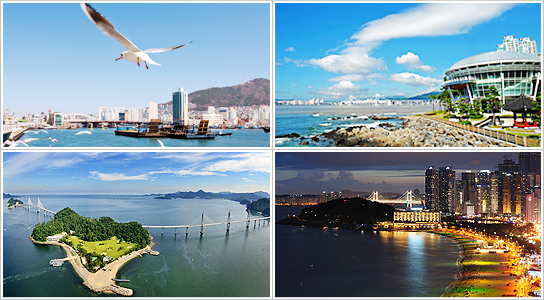
Located in the southeast region of the Korean peninsula, Busan is the country's largest port city and boasts an abundance of coastal tourist attractions, historical and cultural sites, and trendy shopping areas. The city has a well-developed public transportation system, but for a more convenient and all-inclusive tour, hop aboard the Busan City Tour. The Busan City Tour is comprised of a variety of one-day courses that cover some of the area's major attractions (Haeundae Beach, Taejongdae Resort Park, BEXCO, Jagalchi Market, Dalmaji-gil Road, etc.). The Circulatory Tour covers Taejonogdae Resort Park and Haeundae Beac; the History and Culture Exploration Tour includes major historic sites; the Natural Ecology Tour introduces the rich ecosystem of Busan; the Night View Tour shows some of the city's most fascinating nighttime attractions. Each seat on the bus is equipped with an individual TV screen, providing visitors with information about the stops along the way in a presentation of images, video clips, animation, and more. For international travelers, audio services are offered in English, Japanese, and Chinese. For the circulatory tour course, visitors can purchase an all-day ticket to get on and off a bus at any time throughout the day. Embark on a Busan City Tour bus and learn more about the best sights Busan has to offer!
☞ Busan City Tour Bus Information
Haeundae & Taejongdae Tour (circulatory tour)
Circulation tour buses make round trips between Busan station and Haeundae Beach and between Busan station and Taejongdae Resort Park. All-day tickets allow visitors to get on and off the bus at any stop, offering an affordable way to visit many attractions in Busan.
Departure time: First bus at 09:30, last bus at 17:00 (departure every 30 minutes)
Travel time: About 1 hour 40 minutes (total travel time on the bus if not getting off at any stops)
Bus itinerary:
[For Haeundae Beach]
Busan Station → Busan Museum → Gwangalli Beach → Nurimaru APEC House →Haeundae Beach (Busan Aquarium) → Haeundae Station → Shinsegae Department Store (Busan Centum City branch) and Lotte Department Store (Centum City branch) → Busan Museum of Art (BEXCO)) → Gwangandaegyo Bridge(pass) → UN Memorial Park → Busan Station
[For Taejongdae Resort Park]
Busan Station → Busan Port Passenger Terminal → 75 Square → Taejongdae Resort Park → National Maritime Museum (International Cruise Terminal) → Namhangdaegyo Bridge (pass) → Songdo Beach → BIFF Square (formerly PIFF Square) and Jagalchi Market → Busan Station
* With an all-day ticket, tourists can get on and off a circulatory tour bus any time at any stop during the day (subject to seat availability).
History and Culture Exploration Tour (theme tour)
The tour covers major historical sites of Busan, including the Bokcheon Museum featuring various relics unearthed in the area, Geumgang Park with its cultural relics, and Beomeosa Temple, a major Buddhist center in Korea.
Departure time: 09:20 (one departure a day)
Travel time: About 4 hours 10 minutes
Bus itinerary:Busan station → Gold Theme Street (pass) → Seomyeon 1-ga (pass) → Bokcheon Museum (Busan) (30 minutes) → Geumgang Park (60 minutes) →Beomeosa Temple (40 minutes) → Beonyeong-ro (pass) → Busan station
Haedong Yonggungsa Temple Tour (theme tour)
Although many Korean temples are located in the mountains, Haedong Yonggungsa sits on the rocky shores of the East Sea. A unique intersection of spirituality and nature, the temple is the focal point of this tour.
Departure time: 14:00 (one departure a day)
Travel time: About 3 hours 50 minutes
Bus itinerary: Busan station → Gwangalli Beach (pass) → Haeundae Beach (pass) → Haeundae Dalmaji-gil Road (pass) → Songjeong Beach (30 minutes) → Haedong Yonggungsa Temple (50 minutes) → Gwangandaegyo Bridge (pass) → Busan station
Eulsukdo Natural Ecology Tour (theme tour)
The course covers major attractions in the western part of Busan, including the natural ecology of Eulsukdo Island where visitors can view migratory birds (Designated Natural Monument).
Departure time: 09:40, 14:10 (two departures a day)
Travel time: About 3 hours and 40 minutes
Bus itinerary: Busan station → Yeongdodaegyo Bridge (pass) → Namhangdaegyo Bridge (pass) → Songdo Beach (pass) → Amnam Park (20 minutes) → Dadaepo Beach and Morundae Hill (pass) → Amisan Mountain Observatory (20 minutes) →Nakdong Estuary Eco Center (60 minutes) → BIFF Square (formerly PIFF Square)and Jagalchi Market (pass) → Busan station
Night View Tour (theme tour)
The city tour bus passes by Gwangalli Beach and Haeundae Beach and over the beautifully lit Gwangandaegyo Bridge. Then, it goes up Geumnyeongsan Mountain for an expansive night view of Busan, the highlight of the tour.
Departure time: October-April 19:00, May-September 19:30 (one departure a day) Travel time: About 2 hours 30 minutes
Bus itinerary: Busan station → Gwangalli Beach → Haeundae Beach → Haeundae Dalmaji-gil Road → Gwangandaegyo Bridge → Geumnyeonsan Youth Training Institute → Busan station
* There is a ten-minute photo time in Haeundae Beach and Geumnyeonsan Mountain, but the bus does not make other stops.
Circulation tour buses make round trips between Busan station and Haeundae Beach and between Busan station and Taejongdae Resort Park. All-day tickets allow visitors to get on and off the bus at any stop, offering an affordable way to visit many attractions in Busan.
Departure time: First bus at 09:30, last bus at 17:00 (departure every 30 minutes)
Travel time: About 1 hour 40 minutes (total travel time on the bus if not getting off at any stops)
Bus itinerary:
[For Haeundae Beach]
Busan Station → Busan Museum → Gwangalli Beach → Nurimaru APEC House →Haeundae Beach (Busan Aquarium) → Haeundae Station → Shinsegae Department Store (Busan Centum City branch) and Lotte Department Store (Centum City branch) → Busan Museum of Art (BEXCO)) → Gwangandaegyo Bridge(pass) → UN Memorial Park → Busan Station
[For Taejongdae Resort Park]
Busan Station → Busan Port Passenger Terminal → 75 Square → Taejongdae Resort Park → National Maritime Museum (International Cruise Terminal) → Namhangdaegyo Bridge (pass) → Songdo Beach → BIFF Square (formerly PIFF Square) and Jagalchi Market → Busan Station
* With an all-day ticket, tourists can get on and off a circulatory tour bus any time at any stop during the day (subject to seat availability).
History and Culture Exploration Tour (theme tour)
The tour covers major historical sites of Busan, including the Bokcheon Museum featuring various relics unearthed in the area, Geumgang Park with its cultural relics, and Beomeosa Temple, a major Buddhist center in Korea.
Departure time: 09:20 (one departure a day)
Travel time: About 4 hours 10 minutes
Bus itinerary:Busan station → Gold Theme Street (pass) → Seomyeon 1-ga (pass) → Bokcheon Museum (Busan) (30 minutes) → Geumgang Park (60 minutes) →Beomeosa Temple (40 minutes) → Beonyeong-ro (pass) → Busan station
Haedong Yonggungsa Temple Tour (theme tour)
Although many Korean temples are located in the mountains, Haedong Yonggungsa sits on the rocky shores of the East Sea. A unique intersection of spirituality and nature, the temple is the focal point of this tour.
Departure time: 14:00 (one departure a day)
Travel time: About 3 hours 50 minutes
Bus itinerary: Busan station → Gwangalli Beach (pass) → Haeundae Beach (pass) → Haeundae Dalmaji-gil Road (pass) → Songjeong Beach (30 minutes) → Haedong Yonggungsa Temple (50 minutes) → Gwangandaegyo Bridge (pass) → Busan station
Eulsukdo Natural Ecology Tour (theme tour)
The course covers major attractions in the western part of Busan, including the natural ecology of Eulsukdo Island where visitors can view migratory birds (Designated Natural Monument).
Departure time: 09:40, 14:10 (two departures a day)
Travel time: About 3 hours and 40 minutes
Bus itinerary: Busan station → Yeongdodaegyo Bridge (pass) → Namhangdaegyo Bridge (pass) → Songdo Beach (pass) → Amnam Park (20 minutes) → Dadaepo Beach and Morundae Hill (pass) → Amisan Mountain Observatory (20 minutes) →Nakdong Estuary Eco Center (60 minutes) → BIFF Square (formerly PIFF Square)and Jagalchi Market (pass) → Busan station
Night View Tour (theme tour)
The city tour bus passes by Gwangalli Beach and Haeundae Beach and over the beautifully lit Gwangandaegyo Bridge. Then, it goes up Geumnyeongsan Mountain for an expansive night view of Busan, the highlight of the tour.
Departure time: October-April 19:00, May-September 19:30 (one departure a day) Travel time: About 2 hours 30 minutes
Bus itinerary: Busan station → Gwangalli Beach → Haeundae Beach → Haeundae Dalmaji-gil Road → Gwangandaegyo Bridge → Geumnyeonsan Youth Training Institute → Busan station
* There is a ten-minute photo time in Haeundae Beach and Geumnyeonsan Mountain, but the bus does not make other stops.
| More info |
|---|
| Departures Busan City Tour buses leave from the Hotel Arirang Busan near Busan Station Square (Busan Subway Line 1: Busan station, exit 8; Train: Busan station, exit 1) How to use Circulatory tour: Get off the bus at whichever stop you'd like and tour the area until the next bus comes (subject to seat availability). Theme tours: No transfers Tour price: Adults (ages 19 and up)-10,000 won, children and teenagers (ages between 4 and 18) – 5,000 won Discounts (applies to adults taking the circulatory tour only): 1) A 20% discount applies to those holding any of the following: - Air Busan boarding pass (less than ten days must have passed since the date on the boarding pass) - International cruise boarding pass - KTX ticket on that day - Welfare card for the disabled (discount also applies to one accompanying person) - One adult staff accompanying elementary, junior high, or high school students holding a Busan Saturday Scool pass card - BEXCO yacht tour boarding pass - A group of adult and children of three persons or more visiting on a weekday (Monday through Friday) who present documentation showing that they are a family 2) A 50% discount applies to those holding the following - A copy of documents showing that the adult has three children or more (ID card and multiple children card issued by the Busan Metropolitan City Government) 3) Children under the age of 4 can board for free if accompanied by a guardian 4) 8,000 won per person for groups of 10 or more adults Ticket purchase Online reservation: www.citytourbusan.com (Korean, English, Japanese, Chinese) Phone reservation: ARS +82-1688-0098 (Korean, English, Japanese, Chinese), TEL +82-51-464-9898 (Korean, English) * Receive your ticket from the bus driver on the day of the tour. On-site purchase: If you do not have a reservation, you can purchase a ticket from the bus driver at one of the bus stops if there are seats available. * For theme tours, tickets are only sold at the Busan Station bus stop. * No reservation is taken for the Haeundae & Taejongdae Tour (circulatory tour) leaving after 11:30 on weekdays or at any time on weekends or holidays (available on site on a first-come, first-served basis). Closed on Mondays (unless Monday is a national holiday) 1330 Korea Travel Hotline: +82-2-1330 (Korean, English, Japanese, Chinese) Busan City Tour website: http://www.citytourbusan.com/citytour_2010/eng(Korean, English, Japanese, Chinese) Busan Tourism Office website: http://etour.busan.go.kr (Korean, English, Japanese, Chinese) |
Busan Museum
At the Busan Museum, collections of local artifacts and documents tell the history of the Busan area—from prehistoric times to the modern era. The museum also runs hands-on traditional cultural programs and folk classes to share the proud legacy of Korean traditional culture with museum visitors.
☞ Go to Busan Museum
☞ Homepage: http://engmuseum.busan.go.kr/ (Korean, English, Japanese, Chinese, Russian)
☞ Homepage: http://engmuseum.busan.go.kr/ (Korean, English, Japanese, Chinese, Russian)
Haeundae Beach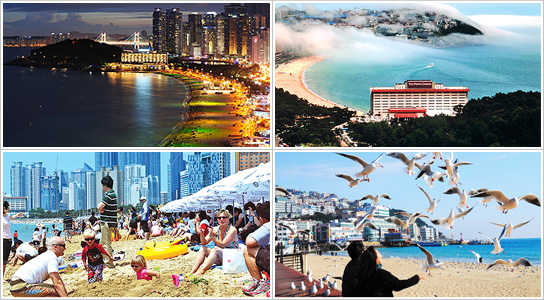
Sandwiched between Haeundae Dalmaji-gil Road (on the right) and Dongbaekseom Island (to the left), Haeundae Beach is an expansive, white-sand beach that is one of the most popular tourist sites in Busan. The beach is easily accessible via public transportation and is an ideal festival venue, hosting events like the The New Year Festival, Busan, Polar Bear Swimming Contest, the Haeundae Sand Festival, and other celebrations throughout the year. In late fall, the beach serves as one of the stages of the famous Busan International Film Festival (BIFF). Beloved by travelers for its convenient location, this gorgeous stretch of sand is particularly alluring at night when the light from the nearby buildings sparkles off the ink-black waves.
Taejongdae Resort Park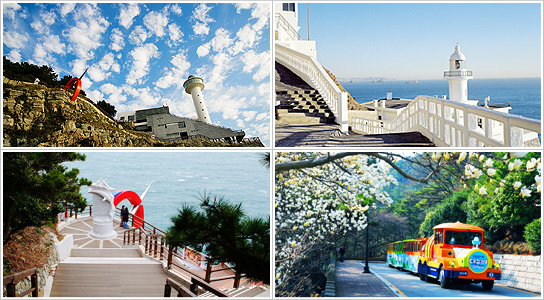
Located in the southernmost region of Busan, Taejongdae Resort Park stretches for 9.1 kilometers along the Yeongdo Coast and boasts an area of 440 acres. The top of the highest cliff (250 meters above sea level) is home to about 120 species of trees and plants. On clear days, you can see as far as Tsushima Island in Japan, almost 56 kilometers away! Often frequented by poets and artists (not to mention throngs of tourists), the striking landscape of the park is rife with sharp cliffs and gnarled rock formations.
Songdo Beach
Named after the colony of pine trees on nearby Geobukseom Island (Turtle Island), Songdo Beach ('song' meaning 'pine trees' in Korean) was redeveloped into a coastal park that is now open year-round. Here, you will find a number of sculptures rising proudly out of the water, including that of a whale that looks as if it's ready to breach. The underground breakwater, fountain, and sculptures give this whimsical coastal park a beauty all its own. For an even more open view of the ocean—and to breathe in a fresh sea breeze—make sure to visit Songnim Park.
BIFF Square
The Theater District in Nampo-dong has been the venue for the Busan International Film Festival (BIFF) since 1996. Following the festival's initial success, the theater area was refurbished and renamed the BIFF Square. The 428-meter-long street that runs from the old Buyeong Theater in Nampo-dong to the Chungmu-dong Bridge is divided into the Street of Stars and the Street of Festival. Every year, handprints of the stars are added to the walkway as the BIFF gets underway with an opening gala packed with special events and films. Not just a prime location during the festival period, BIFF Square bursts with youthful energy and glamour all year round, offering a veritable medley of cinemas, shopping centers, and nightclubs.
Jagalchi Market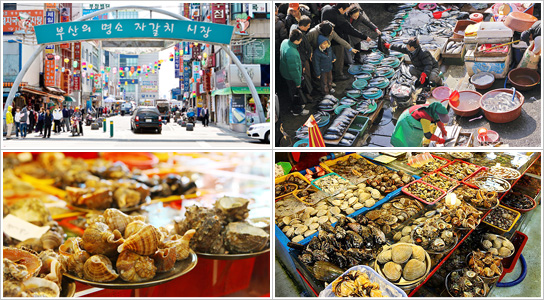
The Jagalchi Market is the largest fish market in Korea. Every day, loads of fresh fish and shellfish are brought into the market and the voices of shoppers and vendors mix to create a pleasant cacophony. The Jagalchi Market is one of the most famous tourist destinations in Busan and is a must-see for international travelers. Come and get a glimpse into the lives of the Busan people. In mid-October of every year, the Busan Jagalchi Festival is held with an array of hands-on programs and cultural performances that celebrate the colorful market and its unique place in history.
☞ Go to Jagalchi Market
☞ Homepage: http://etour.bsjunggu.go.kr (Korean, English, Japanese, Chinese)
☞ Homepage: http://etour.bsjunggu.go.kr (Korean, English, Japanese, Chinese)
Amnam Park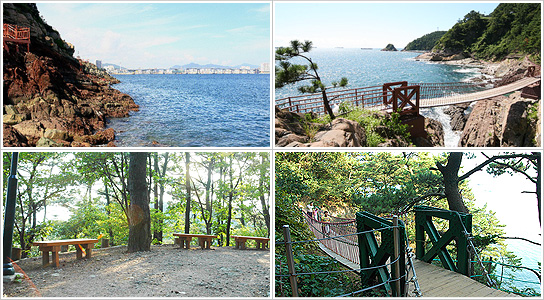
Amnam Park sprawls across Jinjeongsan Mountain in Amnam-dong and offers a spectacular view of the sea out past groves of thick trees. For a closer look at the ocean, walk along the high coastal path or stop by the observatory to get a panoramic view of the sea. While at the observatory, don't forget to look for Dudo (a small island that seems just an arm's-length away) and its picture-perfect, white lighthouse. The regal combination of the park's mountains and seascapes, not to mention the free admission, make this park a highly recommended travel destination. It only takes around 1 hour to walk along the whole park.
Haedong Yonggungsa Temple
Haedong Yonggungsa Temple was first built in 1376 by Naong Hwasang, the great Buddhist teacher of the king in the Goryeo Dynasty. (918-1392). A legend has it that those making a sincere prayer at the temple will see their wish come true. The name of the temple means 'Palace of the Dragon in the East of the Sea.' As the name implies, the temple is stunningly located by the seashore. The way to the temple is awesome, as it is like going into a palace in the sea. The temple features Daeungjeon prayer hall, a three-story stone pagoda, a 108 staircase, a 10-meter high Haesu Gwaneum Daebul (statue of the seaside Goddess Buddha), and a mineral spring.
☞ Go to Haedong Yonggungsa Temple
☞ Official site: http://www.yongkungsa.or.kr (Korean, English, Japanese, Chinese)
☞ Official site: http://www.yongkungsa.or.kr (Korean, English, Japanese, Chinese)
Nakdong Estuary Eco-Center
The habitat of migratory birds of Nakdonggang River estuary is of such high environmental merit that it has even officially been designated Natural Monument No. 179. Therefore, Nakdong Estuary Eco-Center was built to exhibit numerous materials showing the evolution of the estuary and the types of migratory birds that live there. One side of the building is made of glass and boasts a bird's-eye view of the estuary. In addition to exhibits, the center offers interactive programs such as a plant observation program, a field investigation tour of the estuary, and an activity in which participants can build a shack of reeds for bird observation.
☞ Go to Nakdong Estuary Eco-Center
☞ Homepage: wetland.busan.go.kr (Korean, English, Chinese, Japanese)
☞ Homepage: wetland.busan.go.kr (Korean, English, Chinese, Japanese)
Gwangalli Beach
Gwangalli Beach in Suyeong-gu covers an ample space measuring 1.4 kilometers in length and 25 to 110 meters in width. The crescent-shaped beach is covered with fine powdery sand and is only a few meters away from a network of sidestreets lined with coffee shops and over 300 restaurants selling raw fish, eonyan bulgogi, and bean sprout haejangguk. At night, the beach takes on an even more vibrant aura as the sparkling lights brighten the night sky and young visitors flock to the area.
Dalmaji Hill (Haeundae Dalmaji-gil Road
Affectionately called the Montmartre of Busan, Dalmaji-gil is a road that stretches from Haeundae Beach to Dalmaji Hill. Dalmaji-gil gets its name from the romantic view of the moon that seems to rise over the hill as you reach the end of the street ('dal' meaning 'moon' in Korean and 'maji' meaning 'greeting'). All along the road you will find clusters of galleries, unique coffee shops, and restaurants beckoning to you as you stroll past. The area is a popular filming location.
☞ Go to Haeundae Dalmaji-gil Road
☞ Homepage: eng.haeundae.go.kr (Korean, English, Chinese, Japanese)
☞ Homepage: eng.haeundae.go.kr (Korean, English, Chinese, Japanese)
Geumnyeonsan Mountain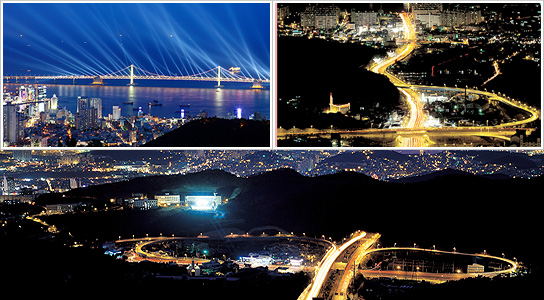
Located in Suyeong-gu standing proudly at 415 meters above sea level, Geumnyeonsan Mountain is home to the remains of the Banyaam Hermitage and Baramilda Temple. The view of the Busan Port and Gwangalli Beach from atop the mountain at night is so beautiful that many people visit the mountain for this view alone. On the mountain you will also find the Youth Training Center, a well, and a hiking trail.
Comments
Post a Comment